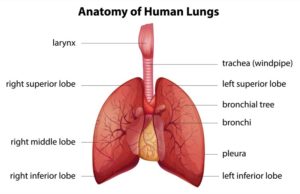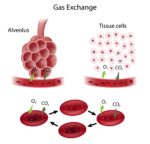 Respiratory systems function is the intake of oxygen and the removal of carbon dioxide. The anatomy of the system is the nose and the mouth. We then go down to the pharynx, the larynx, the trachea, and the primary bronchi, the bronchioles, and then the alveoli. Here is a model of an anatomical model. For example, here, this is the lung that I’ve removed from this side. If we move the lung from the other side, and here, we’ll be demonstrating this idea of the bronchioles and in all the little ones here are the alveoli’s. Okay, that’s quite important that we understand. It’s almost like an upside-down broccoli, as an example of how all the tubes come down.
Respiratory systems function is the intake of oxygen and the removal of carbon dioxide. The anatomy of the system is the nose and the mouth. We then go down to the pharynx, the larynx, the trachea, and the primary bronchi, the bronchioles, and then the alveoli. Here is a model of an anatomical model. For example, here, this is the lung that I’ve removed from this side. If we move the lung from the other side, and here, we’ll be demonstrating this idea of the bronchioles and in all the little ones here are the alveoli’s. Okay, that’s quite important that we understand. It’s almost like an upside-down broccoli, as an example of how all the tubes come down.
Inspirational inhalation is breathing in, and so the diaphragm that sits down here will push out. Then we have the expiration exhalation and this is the breathing out. All this is managed by the diaphragm and the intercostal muscles. External respiration is an exchange of gases between the lungs and the blood, oxygen from the lungs into the blood, and CO2 from the blood into the lungs. Whereas internal respiration is the exchange of gases between cells and blood, O2 from the blood in the cells, and CO2 from the cells into the blood, so if you cut the reverse way around. What happens is we have a system that’s called gaseous exchange and gaseous exchange happens in the alveoli. On this model here, this is right down in these tiny, tiny cells down here, and this is where the body is removing the CO2, and taking in the O2 for the cells in the alveoli.


Pingback: Nose and respiratory problems on your pets and the first aid care
Pingback: Physiotherapy and hydrotherapy are successful ways of treating pets